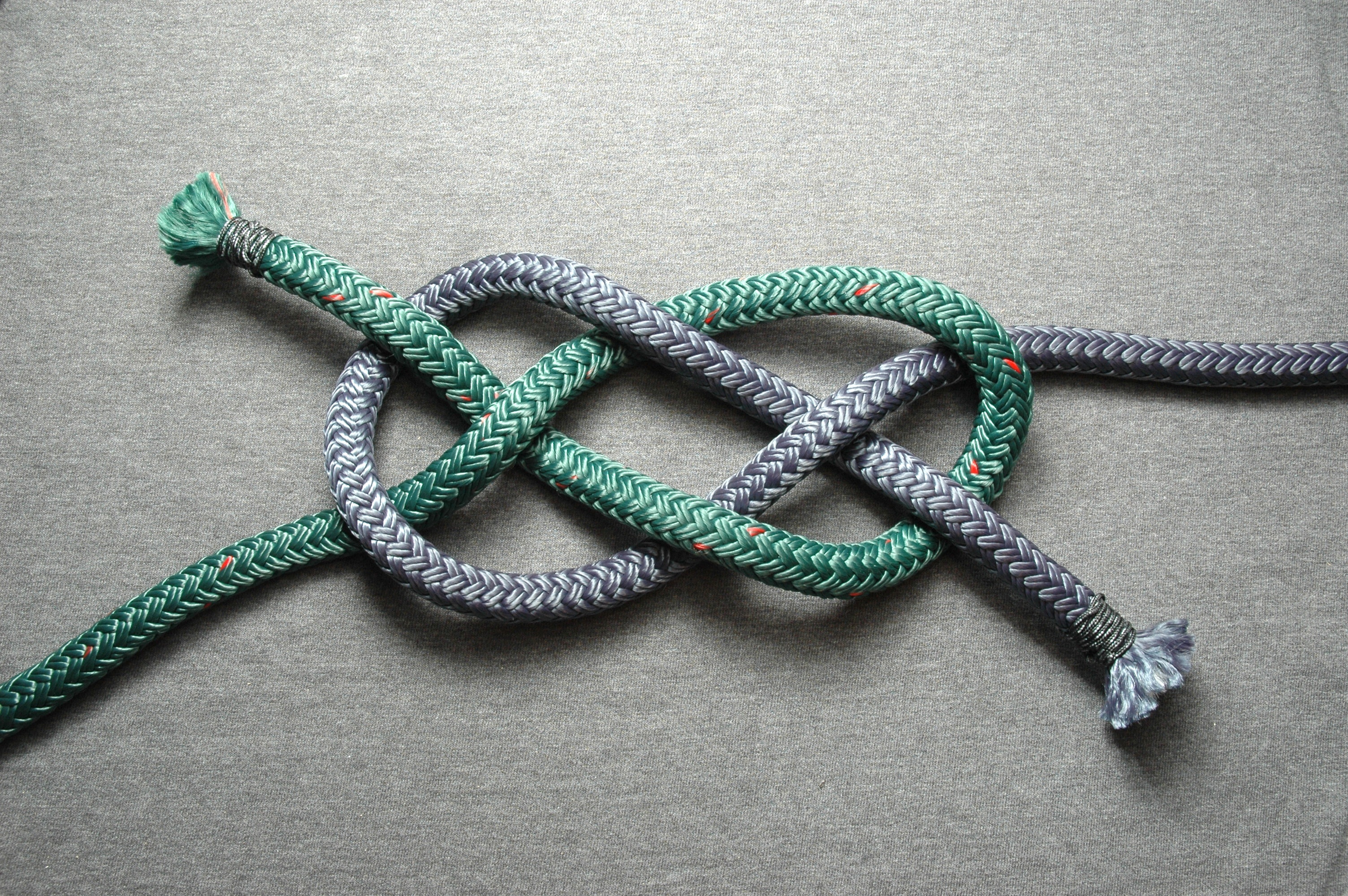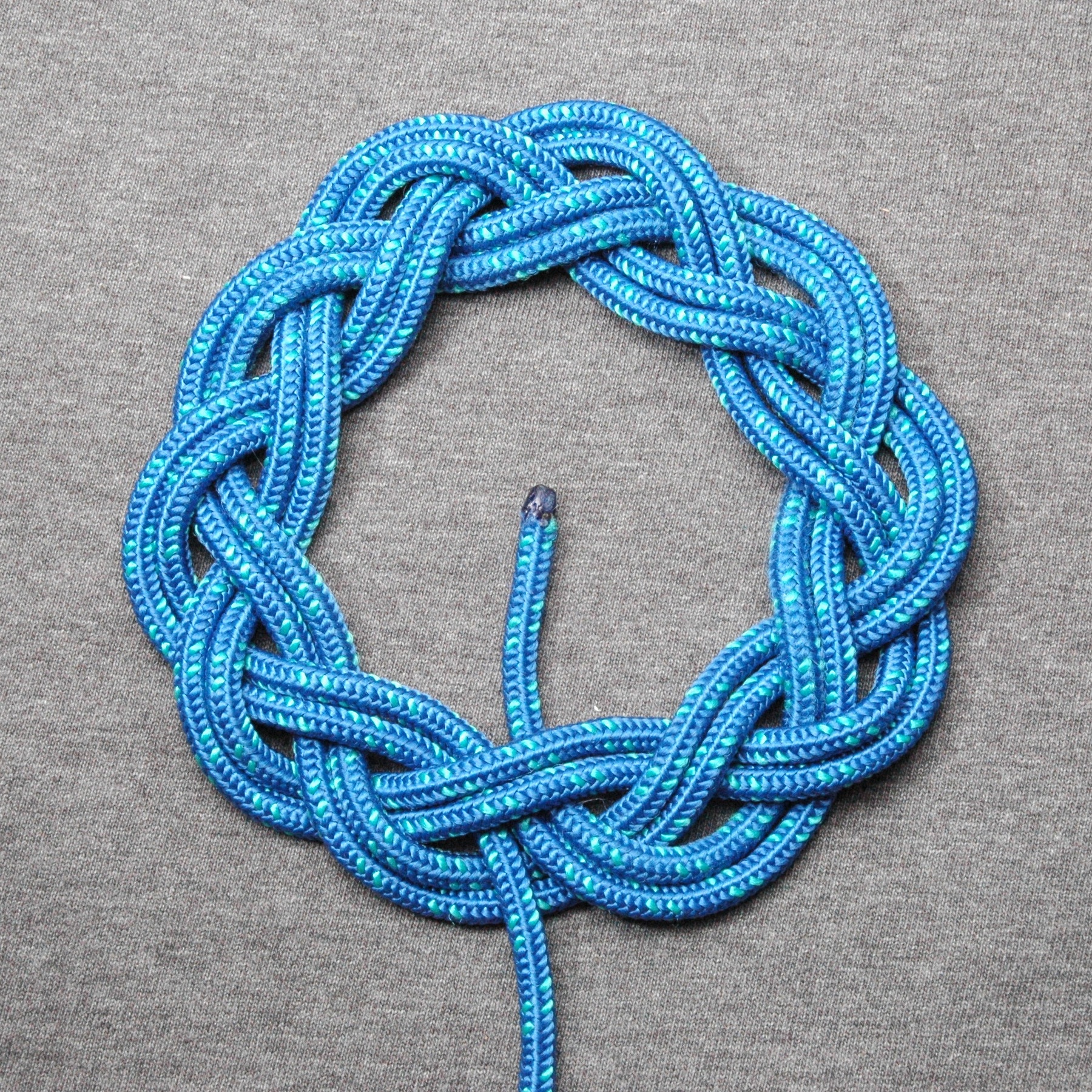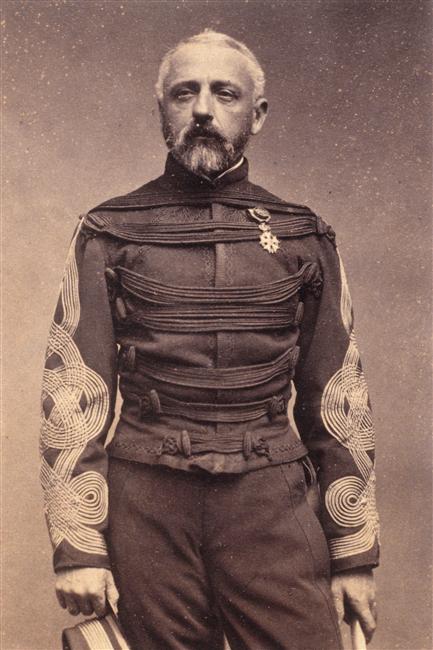|
Carrick Mat
The carrick mat is a flat woven decorative knot which can be used as a mat or pad. Its name is based on the mat's decorative-type Carrick bend#Decorative uses, carrick bend with the ends connected together, forming an endless knot. A larger form, called the prolong knot, is made by expanding the basic carrick mat by extending, twisting, and overlapping its outer bight (knot), bights, then weaving the free ends through them. This process may be repeated to produce an arbitrarily long mat. In its basic form it is the same as a 3-lead, 4-bight Turk's head knot. The basic carrick mat, made with two passes of rope, also forms the central motif in the logo of the International Guild of Knot Tyers. When tied to form a cylinder around the central opening, instead of lying flat, it can be used as a woggle. See also * List of knots References External links * Alternating knots and links Fibered knots and links Fully amphichiral knots and links Hyperbolic knots and links {{D ... [...More Info...] [...Related Items...] OR: [Wikipedia] [Google] [Baidu] |
Carrick Bend
The Carrick bend, also known as the Sailor's breastplate, is a knot used for joining two lines. It is particularly appropriate for very heavy rope or cable that is too large and stiff to be easily formed into other common bends.Geoffrey Budworth, ''The Complete Book of Knots'' (London: Octopus, 1997), 43.Brion Toss, ''Chapman's Nautical Guides: Knots'' (New York: Hearst Marine Books, 1990), 79–80. It will not jam even after carrying a significant load or being soaked with water.Clifford W. Ashley, ''The Ashley Book of Knots'' (New York: Doubleday, 1944), 262–263. As with many other members of the basket weave knot family, the carrick bend's aesthetically pleasing interwoven and symmetrical shape has also made it popular for decorative purposes. Heraldry The Carrick bend is known as the "Wake knot" or "Ormonde knot" when it is used as a heraldic badge.Arthur Charles Fox-Davies, ''A Complete Guide to Heraldry'' (1909), wikisource:A Complete Guide to Heraldry/Chapter 29, p.&nbs ... [...More Info...] [...Related Items...] OR: [Wikipedia] [Google] [Baidu] |
Turk's Head Knot
A Turk's head knot, sometimes known as a sailor's knot, is a decorative knot with a variable number of interwoven strands forming a closed loop. The name refers to a general family of knots, not an individual knot. While this knot is typically made around a cylinder, it can also be formed into a flat, mat-like shape. Some variants can be arranged into a roughly spherical shape, akin to a monkey's fist knot. This knot is primarily used for tightening up underlying material to overlay as a tubular covering knot, prevent slipping, and add a decorative element. A notable practical use for the ''Turk's head'' is to mark the "king spoke" of a ship's wheel (the spoke that is upright when the rudder is in a central position). The knot takes its name from its resemblance to a turban ( tr, sarık), though a turban is wound rather than interwoven. Leads and bights Different types of Turk's head knots are classified according to the number of leads and bights, as well as the method of ... [...More Info...] [...Related Items...] OR: [Wikipedia] [Google] [Baidu] |
Austrian Knot
An Austrian knot (or Hungarian knot), alternatively warrior's knot or , is an elaborate design of twisted cord or lace worn as part of a dress uniform, usually on the lower sleeve. It is usually a distinction worn by officers; the major exception is the hussars, in which Austrian knots are worn by all ranks. British cadet under officers wear Austrian knots as part of their rank insignia. History Of Hungarian origin, the (in English "warrior's knot") evolved as an indicator of rank among hussars of the Hungarian army, and became part of the Hungarian noble attire since the 16th century. Later, as other nations added hussars to their armies, they started to use the knot as well. The reason for this was that hussar regiments were often established by Hungarian nobles and some retained the name of their founder; for example the Ladislas Ignace de Bercheny. In the Austrian (later Austro-Hungarian) army of the 18th century epaulettes were widely perceived as foreign (due to their ... [...More Info...] [...Related Items...] OR: [Wikipedia] [Google] [Baidu] |
Adventuress - On Deck - Detail 01
Adventuress may refer to: *A female adventurer * ''Adventuress'' (schooner) * Adventuress (dinghy) *''The Adventuress'', American title of the 1946 British drama film ''I See a Dark Stranger ''I See a Dark Stranger'' – released as ''The Adventuress'' in the United States – is a 1946 British World War II spy film with touches of light comedy, by the team of Frank Launder and Sidney Gilliat, and starring Deborah Kerr and ...'' *'' An Adventuress'', a 1920 American drama film directed by Fred J. Balshofer {{disambig ... [...More Info...] [...Related Items...] OR: [Wikipedia] [Google] [Baidu] |
Knot
A knot is an intentional complication in cordage which may be practical or decorative, or both. Practical knots are classified by function, including hitches, bends, loop knots, and splices: a ''hitch'' fastens a rope to another object; a ''bend'' fastens two ends of a rope to each another; a ''loop knot'' is any knot creating a loop; and ''splice'' denotes any multi-strand knot, including bends and loops. A knot may also refer, in the strictest sense, to a stopper or knob at the end of a rope to keep that end from slipping through a grommet or eye. Knots have excited interest since ancient times for their practical uses, as well as their topological intricacy, studied in the area of mathematics known as knot theory. History Knots and knotting have been used and studied throughout history. For example, Chinese knotting is a decorative handicraft art that began as a form of Chinese folk art in the Tang and Song Dynasty (960–1279 AD) in China, later popularized in t ... [...More Info...] [...Related Items...] OR: [Wikipedia] [Google] [Baidu] |
Endless Knot
Endless knot in a Burmese Pali manuscript The endless knot or eternal knot is a symbolic knot and one of the Eight Auspicious Symbols. It is an important symbol in Hinduism, Jainism and Buddhism. It is an important cultural marker in places significantly influenced by Tibetan Buddhism such as Tibet, Mongolia, Tuva, Kalmykia, and Buryatia. It is also found in Celtic and Chinese symbolism. History The endless knot appears on clay tablets from the Indus Valley civilization (2500 BC) and on a historic era inscription. Interpretations Buddhism Various Buddhist interpretations of the symbol are: * The endless knot iconography symbolised Samsara ''i.e.'', the endless cycle of suffering of birth, death and rebirth within Tibetan Buddhism. * The inter-twining of wisdom and compassion. * Interplay and interaction of the opposing forces in the dualistic world of manifestation, leading to their union, and ultimately to harmony in the universe. * The mutual dependence of relig ... [...More Info...] [...Related Items...] OR: [Wikipedia] [Google] [Baidu] |
Bight (knot)
In knot tying, a bight is a curved section or slack part between the two ends of a rope, string, or yarn.. "Any slack part of a rope between the two ends, particularly when curved or looped." A knot that can be tied using only the bight of a rope, without access to the ends, is described as in the bight. The term "bight" is also used in a more specific way when describing Turk's head knots, indicating how many repetitions of braiding are made in the circuit of a given knot. Bight vs. open loop Sources differ on whether an open loop or U-shaped curve in a rope qualifies as a bight. treats bights and loops as distinct, stating that a curve "no narrower than a semicircle" is a bight, while an open loop is a curve "narrower than a bight but with separated ends". However, ''The Illustrated Encyclopedia of Knots'' (2002) states: "Any section of line that is bent into a U-shape is a bight." Slipped knot In order to make a slipped knot (also slipped loop and quick release knot), ... [...More Info...] [...Related Items...] OR: [Wikipedia] [Google] [Baidu] |
Logo
A logo (abbreviation of logotype; ) is a graphic mark, emblem, or symbol used to aid and promote public identification and recognition. It may be of an abstract or figurative design or include the text of the name it represents as in a wordmark. In the days of hot metal typesetting, a logotype was one word cast as a single piece of type (e.g. "The" in ATF Garamond), as opposed to a Typographic ligature, ligature, which is two or more letters joined, but not forming a word. By extension, the term was also used for a uniquely set and arranged typeface or colophon (publishing), colophon. At the level of mass communication and in common usage, a company's logo is today often synonymous with its trademark or brand.Wheeler, Alina. ''Designing Brand Identity'' © 2006 John Wiley & Sons, Inc. (page 4) Etymology Online Etymology Dictionary, Douglas Harper's Online Etymology Dictionary states that the term 'logo' used in 1937 "probably a shortening of logogram". History Numerous inv ... [...More Info...] [...Related Items...] OR: [Wikipedia] [Google] [Baidu] |
International Guild Of Knot Tyers
The International Guild of Knot Tyers (or IGKT) is a worldwide association for people with an interest in knots and knot tying. Formation and beginning Officially established in 1982, the founding members were initially drawn together by the 1978 publication in ''The Times'' of an allegedly new knot, the Hunter's bend. The idea for a knotting association of some kind grew from the contact between two people. Des Pawson was a retail manager for a large stationery firm based in Ipswich and a knot craftsman. Geoffrey Budworth was a Metropolitan Police Inspector and knotting consultant. Des first wrote to Geoff on 8 October 1978. They met before the month was over, and if it was not mentioned then the idea of contacting other knotting enthusiasts was raised by Des in a letter dated July, 1980, when he pressed for a suitable venue and suggested The Maritime Trust. Even then, 1981 went by without further development; and this is a source of regret to them both as it was the centena ... [...More Info...] [...Related Items...] OR: [Wikipedia] [Google] [Baidu] |
Woggle
A woggle (or ''neckerchief slide'') is a device to fasten the neckerchief, or scarf, worn as part of the Scout or Girl Guides uniform, originated by a Scout in the 1920s. Name origin One story relating to the origin of the word 'woggle' is that it was named to rhyme with the word ''boon doggle'' used in America. However the term woggle pre-dates the first known reference to this in 1925. There are a few other references to the word woggle before its adoption by the Scout movement. It is thought that woggle was a verb, with similar meanings to waggle and wobble, in the 16th century. It was in limited use as a noun around 1900. Another report is that William 'Bill' Shankley, while working at Gilwell Park with Scouting's founder, prior to 1922, called it a woggle, 'a name given to something without a name'. Earliest use The earliest known reference to a woggle is the June 1923 edition of British '' The Scout''. The term was quickly applied to other designs of fastener, of ma ... [...More Info...] [...Related Items...] OR: [Wikipedia] [Google] [Baidu] |
List Of Knots
This list of knots includes many alternative names for common knots and lashings. Knot names have evolved over time, and there are many conflicting or confusing naming issues. The overhand knot, for example, is also known as the thumb knot. The figure-eight knot is also known as the Savoy knot or the Flemish knot. A * Adjustable Bend – can be easily lengthened or shortened * Adjustable Grip Hitch – a simple hitch which may easily be shifted up and down the rope while slack *Albright Special – used to tie two different diameters of line together, for instance to tie monofilament to braid *Alpine Butterfly (also known as Butterfly Loop) – a static loop mostly used by mountain climbers and rappellers for securing a carabiner to static rope. * Alternate Ring Hitching – covering a ring in hitching can prevent damage * Anchor Bend – attaching a rope to a ring or similar termination *Angler's Loop – knot which forms a fixed loop. Useful for fine or slippery line, it is ... [...More Info...] [...Related Items...] OR: [Wikipedia] [Google] [Baidu] |
Alternating Knots And Links
In knot theory, a knot or link diagram is alternating if the crossings alternate under, over, under, over, as one travels along each component of the link. A link is alternating if it has an alternating diagram. Many of the knots with crossing number less than 10 are alternating. This fact and useful properties of alternating knots, such as the Tait conjectures, was what enabled early knot tabulators, such as Tait, to construct tables with relatively few mistakes or omissions. The simplest non-alternating prime knots have 8 crossings (and there are three such: 819, 820, 821). It is conjectured that as the crossing number increases, the percentage of knots that are alternating goes to 0 exponentially quickly. Alternating links end up having an important role in knot theory and 3-manifold theory, due to their complements having useful and interesting geometric and topological properties. This led Ralph Fox to ask, "What is an alternating knot?" By this he was asking what non-diag ... [...More Info...] [...Related Items...] OR: [Wikipedia] [Google] [Baidu] |





